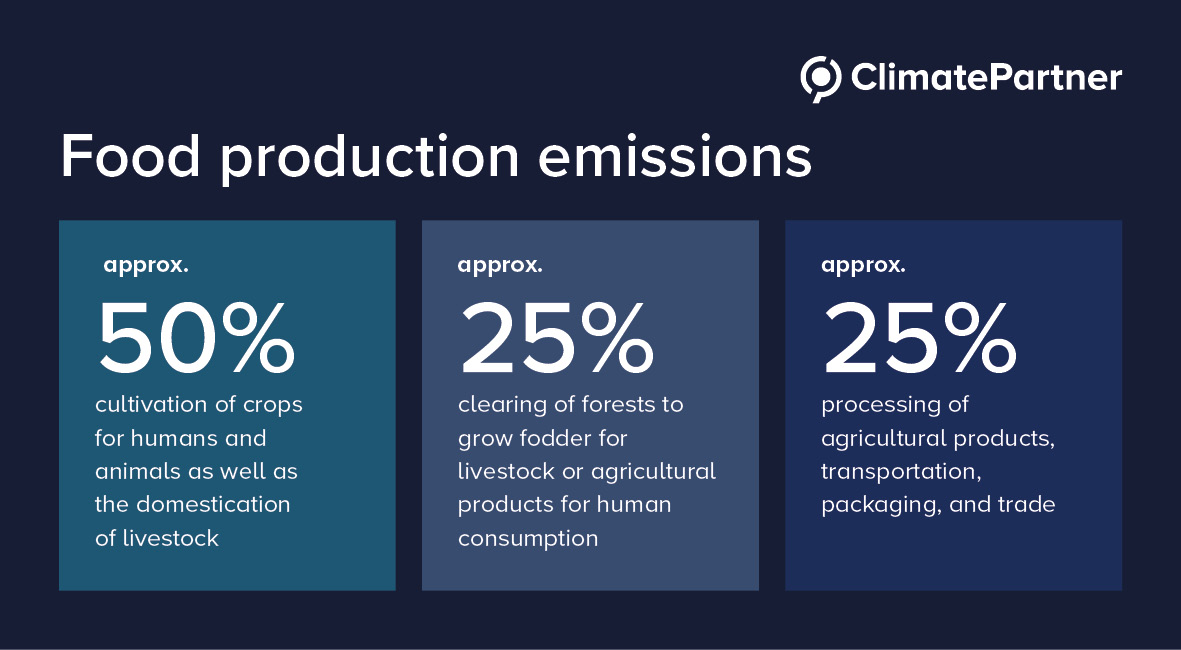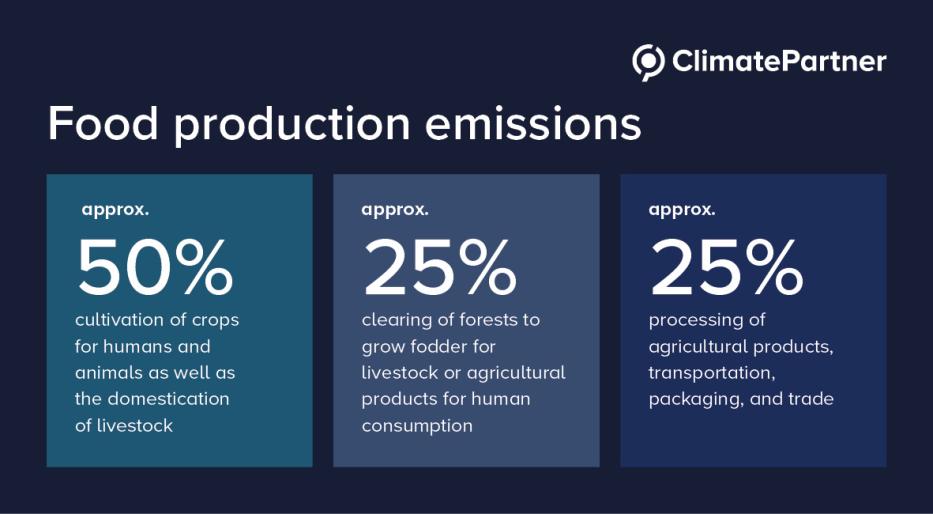How can we eat in a more climate-friendly way? The supply chain from farmers to food retailers
January 21, 2025
Over a quarter (26%) of all global carbon emissions are caused by food production.
That sounds like a lot at first – but on the other hand, food and drink are the basic needs of human existence. We can't simply do without them like we can without air travel or the latest cell phone. In this article, we explain the players involved in the production of food and decarbonisation levers available in the food industry.
Food production emissions
To reduce emissions, we need to understand where and how they are generated. A rough overview is as follows:
- The cultivation of crops for humans and animals as well as the domestication of livestock are responsible for over 50% of emissions in the agricultural sector.
- Almost a quarter of total emissions come from "land use change" (LUC), mostly from the clearing of forests to grow fodder for livestock or agricultural products for human consumption.
- The processing of agricultural products, transportation, packaging, and trade cause the remaining emissions in the food sector

Source: Graphic ClimatePartner
Emission reductions, but how?
What can we do to both reduce carbon emissions and continue to ensure an adequate supply of safe, healthy, and tasty food?
With food retailers (LEH) – producers as manufacturers of tradable products and farmers as the actual producers of food – there are three levels of value-creation, each with their own strategies for dealing with the challenges of climate change.
The food retail trade
The food retail sector plays a decisive role, as it represents the link between producers and consumers.
At the beginning of any climate journey, a complete carbon footprint creates the necessary transparency about one's own emissions and those of the supply chain, which is therefore the basis for effective emission reductions. Because retail companies trade products in high frequencies and every product is reflected in the carbon footprint, food retailers have relatively large carbon footprints. The focus of the calculation of these emissions are in the scope 3 category, which is generally complex and requires close collaboration between the purchasing departments and the calculation service provider. Due to their size, most food retail companies will also be required to report under the EU Corporate Sustainability Reporting Directive (CSRD) in the coming years, meaning that the annual calculation and disclosure of their full carbon footprint will become a legal obligation.
Companies in the food industry are also usually subject to the calculation rules of the Forest, Land and Agriculture (FLAG) sector: the emissions must also be allocated to various sub-sectors of land cultivation and use. Among other things, this makes it clear how many emissions a product creates due to changes in land use. Beef from South America, for example, causes high emission levels because forests are often cleared to feed the cattle. This transparency is therefore needed for the switch to deforestation-free supply chains.
Most European companies in the food retail sector have now set themselves science-based targets for emission reductions in accordance with the rules of the Science Based Targets initiative (SBTi) and have had them validated. The SBTi is an NGO that established industry-specific emission reduction paths based on the globally recognised reports of the Intergovernmental Panel on Climate Change (IPCC). Anyone interested can look up the targets set on the SBTi dashboard: https://sciencebasedtargets.org/target-dashboard. All major German retailers can also be found there with their targets.
Consulting companies such as ClimatePartner support food retailers in developing and setting such science-based climate targets. Each company must define ambitious targets over a period of 5-10 years and can also optionally commit to a net zero target by 2050 at the latest. The integration of emissions from the company's supply chain (i.e. scope 3) is crucial to the success of these targets. This means that food retailers take responsibility for these emissions and work together with their suppliers to reduce them.
Relevant emission reductions can be achieved in the food retail sector through their stores, logistics operations, and distribution centres. One particular focus here is on low-emission heating and cooling production, the generation and purchase of green electricity, and the gradual electrification of transportation. However, reducing emissions "further up the supply chain" – i.e. at the producers – is crucial to achieving climate targets as the focus of emissions from food retail lies in the goods purchased.
Producers
The mostly medium-sized producers play a decisive role in the food industry because they produce tradable products for retailers from the agricultural produce of farmers.
As with food retail, transparency about one's own emissions by means of complete and high-quality carbon footprints is the starting point. The more detailed the status quo analysis is, the more precise hot spots can be identified and options for reducing emissions can be developed. ClimatePartner determines the emissions using so-called activity data. In addition to energy consumption in production, the countries of origin and cultivation methods of purchased ingredients, as well as the exact transportation routes and types, are used to calculate emissions.
After measuring emissions and setting targets, the next step is to reduce emissions. Producers start with their own production and logistics processes but as with food retailers, the purchase of agricultural products in scope 3 is usually the largest source of emissions for manufacturers.
In reduction projects, consulting companies work with producers to develop detailed action plans on how to reduce both their own and "purchased" emissions. In the case of dairies, for example, purchased milk causes by far the most emissions. However, additional ingredients such as sugar, cocoa, and fruit also drive up emissions.
By sourcing products regionally, long transportation routes can be avoided, which can have a positive impact on the climate. However, you must take a closer look. Heated greenhouses in Germany are often more harmful to the climate than cultivation in southern Europe, including transportation to Germany. Another argument in favour of sourcing from European farmers is that there are virtually no emissions from changes in land use, but only if cows, for example, are not fed with soy from South America. Such reduction projects therefore involve complex questions that can only be answered thanks to close cooperation with suppliers and activity-based data.
For producers in the meat and dairy sector, the question regarding the extent to which lower-emission, plant-based products can and will partially replace animal products exists. Social trends with changing consumer preferences will be a decisive factor here.
Farmers
At the very beginning of the supply chain are the farmers who hold a key position: most emissions in the supply chain occur on the farm and can therefore be best influenced by farmers.
In close cooperation between producers and farmers, issues such as soil cultivation, fertilisation, and crop protection can be optimised from an emissions perspective. In the dairy industry, for example, methane-reducing feed additives significantly improve the carbon footprint. Carbon can also be permanently stored in the soil by reducing tillage, with the potential to achieve net zero in the long term. ClimatePartner cooperates with Klim on these "soil-related" topics. Klim works directly with over 3,500 farmers to support them in their regenerative transformation as well as food companies to make their supply chains resilient and reduce scope 3 emissions. In this way, global food security is improved, a major contribution to climate action is made, and biodiversity is strengthened.
Like the food retail sector, the increased use of green electricity and the gradual electrification of machines and systems previously powered by fossil fuels are also important factors in reducing emissions on farms.
However, something else is crucial: as most carbon-saving measures are associated with higher costs, they can only be implemented if farmers are fairly remunerated. Therefore, the green transformation also requires political backing. The Potsdam Institute for Climate Impact Research published a new study a few days ago; the key finding: a climate tax on food would not only reduce greenhouse gas emissions in German agriculture, but also ensure a social balance.
Conclusion
In summary, it is clear that there are various ways to reduce emissions in agriculture – but it is also a very complex area in which many players need to work closer together sustainably. In addition to ensuring a sufficient supply of safe food, it is also always about finding solutions that are commercially viable for everyone in the long term.
In addition to the professional players, consumers ultimately also have a key role to play. By making sustainable consumption decisions, they have a major influence on the climate-friendliness of food production and can massively promote this through their purchasing behaviour in terms of choice and willingness to pay.
Newsroom
